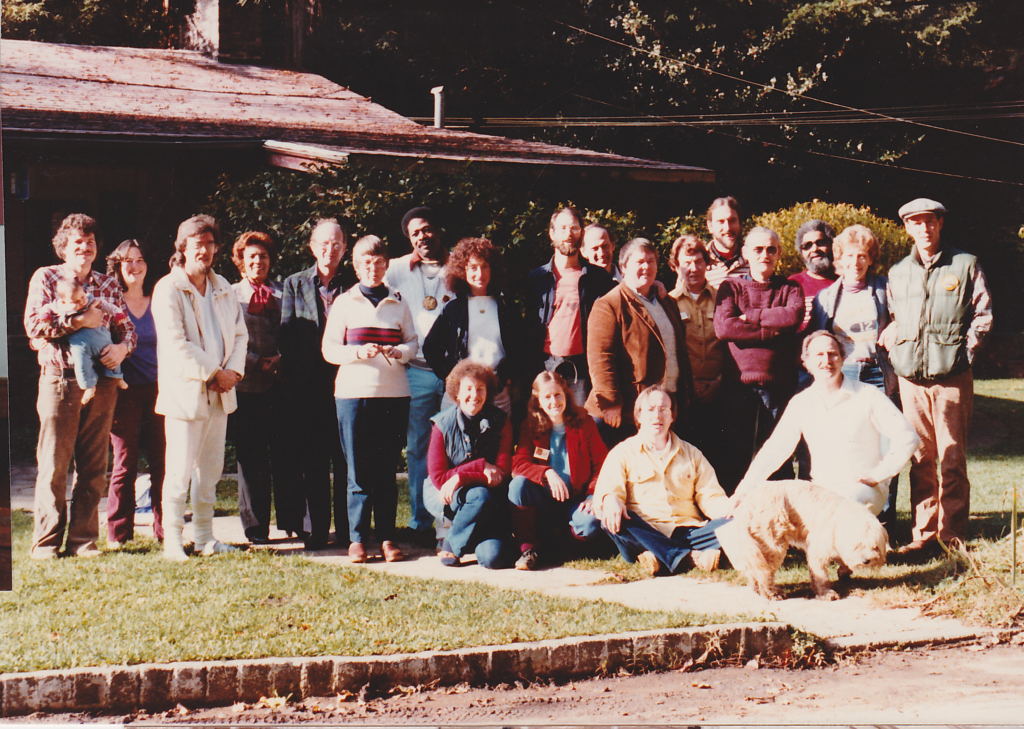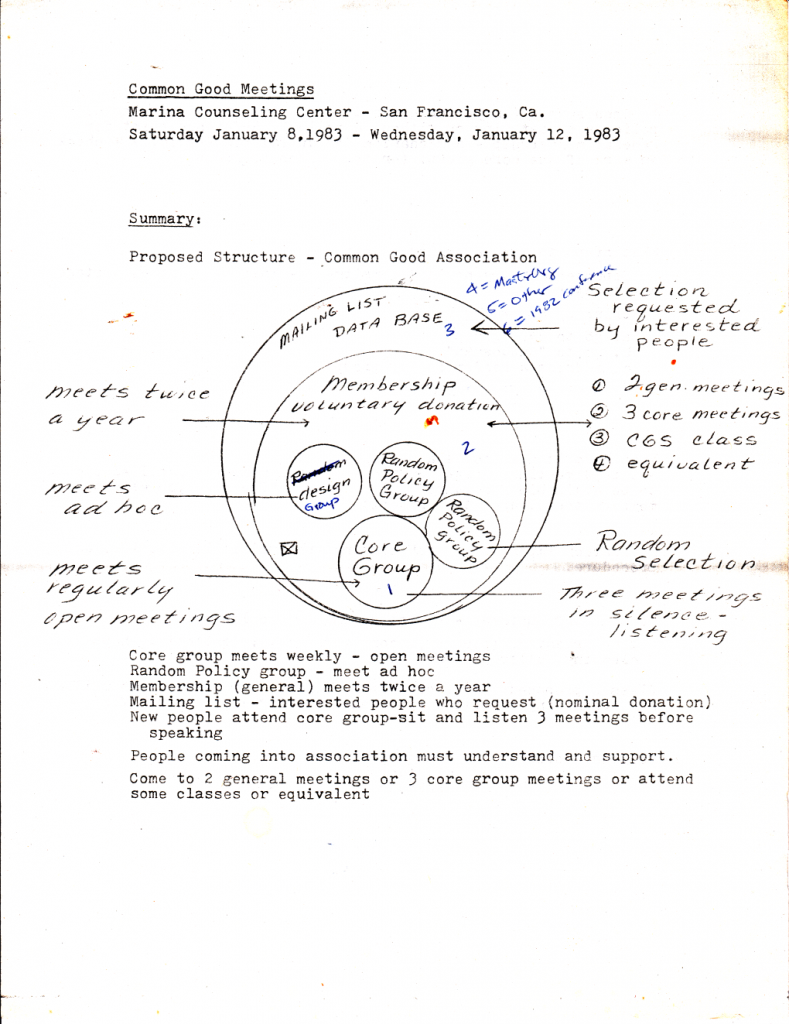Common Good Association and School
A History of the Common Good Association and School
By Michael Phillips (5/4/1983)
Goals and Purpose
In trying to understand an organization, the statement of its major goals or purpose is generally the key. If one were to state the goals or purpose of The Common Good School, it would probably have to be something like:
“This organization exists to promote and help others promote the common good.”
A statement as general as this tends not to be entirely satisfying, however. It leads to more questions than answers. Obviously the first of these questions is: “What is “the common good?” if indeed such a thing exists? It was just such a question that started the whole thing off almost one and a half years ago. The fact that those involved in the organization are still asking that question suggests not that we don’t know what we’re doing, but rather that part of the process as we see it is to continually explore, interest others in exploring, and suggest possible answers.
Beginnings
In October of 1981, a group of more than 30 people—old, young, Black, Asian, unemployed, “Junior League,” and more than half women—some with a great deal of organizing experience to their credit—got together to talk about a need for the new organizing skills they had found useful and the role of new values that demanded new organizing approaches quite different from the Alinsky methods of the 1960s.
In an area as full of community groups as the Bay Area is today (1983), there was not a group or school that could help organizers deal with their problems.
Recognizing that the problems are always different, that different people may employ vastly different methods of organizing, and that the goals of the groups involved may not always be in harmony, a project was begun. It would be a loosely knit group, open to any and all who were interested, and with the goal of promoting the common good through activities of its own and through aiding other groups working in the common good. The sharing of skills and resources would be the key. The format was open to suggestions.
The original group of 30 plus co-founders all committed to helping with the project to create an organization based on this common vision. Ten volunteered to actively help.
Development
For one year, a dozen people met almost every week, 4-6 people at every meeting, to discuss their common values, the way to run meetings using consensus, and to try out new ways to work together. They were referred to as “the core group,” and their meetings were always open to all others. Five times the core group called the larger network together to test out consensus meeting skills, ratify decisions, and get group support. The general meetings ranged from 12 to 32 people, eventually growing to a list of 54. From this year-long process came a style of running meetings, a name for the group, a decision to get like-minded organizers together for a conference, and a statement of position or manifesto was created.
Manifesto or Statement of Position
The Common Good
- The Common Good exists for all people everywhere.
- The Common Good is a process—an understanding of its nature is found deep within each individual.
- Behavior toward finding The Common Good is:
- Favored by compassion for others and respect for their uniqueness.
- Not supported by name-calling, personal attacks, dishonesty, nor violence.
- Favored by encouraging others, offering them support, being honest and open.
- Decisions that lead toward The Common Good are favored by:
- Including the widest possible diversity of people and values.
- Choosing the alternative that is simple, clean, or of higher quality.
- A Common Good School is based on the belief that:
- Conflicts of self-interest can be resolved by finding a common interest that includes the area of conflict.
- Organizers and facilitators can improve their skills with suitable training.
Founding Conference
In November of 1982, 35 Northern California organizers were invited to attend a weekend conference for which they themselves paid. The meeting, near Santa Cruz, was attended by 22 people (eight from the core group, managing logistics and providing facilitation).

The structure and activities of the school were to be discussed. The participants self-organized to determine the agenda and process model of the conference. The major agenda item was the governance and structure of the School. The weekend was enormously successful. It generated intense excitement and enthusiasm to the point of the group not wanting to end the final Saturday evening session. It also gave form, direction, and life to The Common Good School.
The concept of structure and process was determined to be a key to organizing. Everyone agreed that the structure/governance of the school should be worked out such that it could be used as a model for other groups. Each subsequent meeting of The Common Good School (CGS) has been an experiment in a consensus-building process.
Conference Results
Outcomes of the conference included the following:
1. The understanding that there is a new form of [community] organizer and they recognize each other.
2. That they want to support each other, actively and emotionally.
3. That an organization is needed to find and support the new kind of organizer and to make their skills available to more people.
Guidelines for Structure
In January of 1983, two General meetings were called to take the directives of the November conference and create an organizational structure.
- The structure must resemble the values and teachings of the organization.
- The Common Good Association and School will be a non-profit corporation that is NOT tax-exempt. If it ever earns a profit, it will pay taxes. This is to escape the restraint and domination that the IRS can exert on tax-exempt groups, many which have been destroyed in the decade of the 1970s.
- To support itself, it will operate businesses, have a membership fee, and charge tuition for training and fees for consulting services.
- A policy will be made by a membership cohort chosen by a statistically random sampling method. (A member is defined as anyone who makes a donation).
- The policies will be carried out by a “core group” of volunteers. Core group meetings will be open to all members. Full (contributing and voting) participation will require silent observation during attendance at three meetings. (This will filter for commitment to engagement and enable new members to participate effectively, without disrupting the ongoing group process.).
In March of 1983, these guidelines were approved by a random sample of the members.
Action
A randomly selected group met to work on organization policies in April of 1983. The group approved two businesses to pilot as candidates for future revenue generation. The group delegated the final design and budget for these two businesses to teams of interested members in collaboration with the core group. Any unsolvable disagreements among these members would be resolved by using the random sample method to select a temporary, ad-hoc arbitration group.
Two Businesses
The two pilot businesses chosen were:
- A daily appointment calendar and time planner specially designed for community organizers, with a target retail price of $50.
- A computer label service providing mailing addresses for 100 Bay Area radio and TV stations and print media outlets along with the low-cost bulk-mail services needed to best use these labels or for an organizer’s own small mailing list.
The April ad-hoc group also directed the core group to develop a 12-month budget projection.
In May of 1983, the core group met and approved a preliminary budget for
- Hosting of nine workshops
- Production of prototype planner
- Creation of database and printing procedure for mailing labels
Continuing Education
A brief series of low-cost workshops on community organizing was offered during the months of May and June of 1983. These had a second purpose beyond education to attract people who would be interested in a more intensive future training program.
Each workshop was led by a panel of two to three instructors. The series was entitled the “Master Organizer Series.”
Press releases and promotional materials described the events as “Designed for all people who have some organizing experience and wish to improve their skills. Individuals who have organized a PTA group, a neighborhood tree planting, a political campaign, or a new business will find the techniques and strategies offered in this series to be useful.”
Instructors for these workshops were recruited from the November conference participants. The nine, two-hour workshops included:
- New Forms of Organization and Problem Solving for Community Organizers
- Self-Organizing: Aged, Third-World, and Transients
- Alliances and Coalitions: Major Issues
- New Self-Governance and Decision Making Issues
- Effective Strategies for Long-Term Social Change
- Overseas: Special Cultural Organizing Problems
- How to Change Business Institutions
- Gentle Strategies
- Organizing Within Institutions
Veteran community organizers acting as faculty included:
- Peter Berg
- Eric Bear
- Karen Buckley
- Henry Derr
- Lou Durham
- Bob Gnaizda
- John Katz
- Thelma Kavanagh
- Ruth Kadish
- Jaques Kaswan
- Don Kuhn
- Leroy Looper
- Gil Lopez
- Joanna Macy
- Anne Maiden
- Karen Mercer
- Fran Peavey
- Dani Perkins
- Michael Phillips
- John Steiner
- Isabel Wade
- Liz Walker
Founding Members of the Common Good Association
- Greta Alexander
- Dinah Bachrach
- Eric Bear
- Peter Berg
- Clem Bezold
- Karen Buckley
- Robert Burkhardt
- Michael Anne Connelly
- Fred Cook
- Lou Durham
- Andora Freeman
- Greta Goldenman
- Ruth Gravanis
- Jan Hartsough
- Allana Hartzok
- Sterling Johnson
- Peter + Trudy Johnson-Lenz
- Ruth Jones
- Marc Kasky
- Jacques Kaswan
- Jon Katz
- Thelma Kavanagh
- Geoph Kozeny
- Don Kuhn
- Vicki Lee
- Leroy Looper
- Gil Lopez
- Joanna Macy
- Hank Maiden
- Anne Maiden
- Karen Mercer
- Precious More
- David Olsen
- Kristen Olsen
- Charles Albert (Shali) Parsons
- Mart Pearson
- Fran Peavey
- Michael Phillips
- Wendell Phillips
- Lu Phillips
- Roger Pritchard
- Gene Reed
- Ben Richards
- Carol Ruth Silver
- Valerie Skonie
- John Steiner
- Peter Stoddard
- Natasha Torres
- Liz Walker
- Suki Waller
- Gary Warne
- Claude Whitmyer
- Clay Weins
Tech Note: The Common Good Association was an early adopter of microcomputer technology. There was no public access to the Internet at the time. During this period a groupware application entitled MIST+ (Microcomputer Information Support Technology) was used to create a dial-up virtual community, that included a public announcement area, discussion forums, and a database capability that provided:
- Tracking of membership dues and donations
- A directory of members, including:
- Contact information
- Personal Description
- List Segmentation Tags
- A matching capability based on:
- Areas of Experience
- Organizing Issues
- Personal Skills and Talents
- Other Organizational Affiliations
- Job Offers
- Teaching/Training Offers
About half of the members had sufficient computer capability to participate and thermal-printing teletypes with low-speed modems were also made available on a revolving loan basis so that any member who wanted to test out the value of these tools could do so before investing in personal computing equipment.
